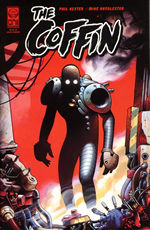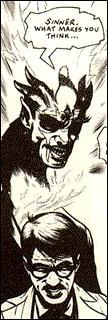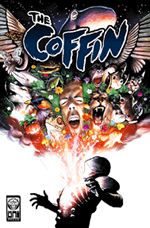>> The Friday Review: The Birthday Riots
>> The Friday Review: A Distant Soil: The Gathering
More...

My mother used to work as a nurse at Leeds General Infirmary, and has an unshakeable belief in life after death. The reason for this is simple:
She's not only seen a ghost, she's talked to one.
Coming on shift one night, she found herself heading down one of the main corridors in the hospital just as one of the long-term patients was heading out. This woman had been at the infirmary for quite a while, and she and the nurses had got on very well. She and my mother passed on the corridor, Mum asked how she was, and the woman replied that she was a lot better, thank you, and she was going home. Mum wished her well and headed to the ward.
Where she was told that the lady in question had died half an hour previously.
For everyone except Mum, this story exists in the borderland between fiction and reality. There any number of explanations, from a fatigue-induced hallucination, a semantic ghost brought on by the environment, a precognitive flash or an actual ghost sighting. We can never know for certain, because we were not there. We don't know whether there's something beyond this life and will not know for sure until this life ends. In short, nothing is certain.
THE COFFIN as a story exists on this same borderline between life and death, faith and certainty. While many other comics have dealt with ghosts or life after death in some form, THE COFFIN is the first to marry this fascination with both horror and anime style choices. It's also got a resolutely fatalist outlook that marks it out from many of the other "mature" titles.
COFFIN deals with Doctor Ashar Ahmad, a scientist employed by Heller Tech to develop a new type of polymer. The polymer Ahmad's team has perfected is the perfect insulator. So perfect that it stops the soul leaving the body on death. In short, Ahmad and his team have built a cage for the soul, a "coffin".

The element that stands out most in THE COFFIN is it's central character, Dr Ashar Ahmad. The lazy response here would be to describe him as a "mad scientist" but that would require him to be capable of emotion. Ahmad is an intellect, a man who is defined purely by his work and its results. Even his final living action, to enter the coffin, demonstrates this. With seconds left to live, the only thing he knows to do is to take shelter, literally, within his work.
In this way, Hester's script repeatedly reinforces its central themes and does so with an impressive degree of subtlety. The reanimated Ahmad is in many ways identical to the scientist in life. He becomes an idea given form, the only change being emphasis. Instead of Ahmad willing the coffin technology into life, now it's the coffin forcing Ahmad to continue to function.
What makes the story particularly horrifying is the true nature of the coffin technology. The script takes great pains to emphasise that the coffin is not keeping Ahmad alive or has even resurrected him. He's dead, his body contained within the coffin, which is in turn preventing his soul from escaping. He is a corpse in a bottle, a dead man who has been denied final rest. There is no attempt to sugarcoat his plight, and much of the script is powered by Ahmad's abject despair at not only what has been done to him, but also what he has done to himself. As a result, his journey through the story is as much an attempt to come to terms with his situation as it is an attempt to take revenge on Heller Corp.
However, Ahmad is also motivated by what waits for him should he ever open the coffin. Hester's script and Huddleston's art treat the reader to a view of Hell that Dante wouldn't feel out of place in. Ahmad is confronted with the Devil, who explains to him that when you die, if you're lucky. There's nothing. If you're not lucky, there is an endless array of Hells, all tailored to suit the sins of their inhabitants.
 Here, Huddleston's artwork really comes into it's own, with the copulating skeletons of the Hell of Adulterers being a particular standout. The overall effect is similar to that of Dark Ages woodcuts, an approach made all the more horrifying when presented to a rational, scientific character such as Ahmad.
Here, Huddleston's artwork really comes into it's own, with the copulating skeletons of the Hell of Adulterers being a particular standout. The overall effect is similar to that of Dark Ages woodcuts, an approach made all the more horrifying when presented to a rational, scientific character such as Ahmad.
The very presence of the Devil in the story is also worth commenting on. This cross-pollination of genres is one of THE COFFIN's strongest points, its continual juxtaposition of ideas keeping the reader both interested and off-balance. This is reflected by the shifting form of the Devil itself, ranging from something approaching the "Old Nick" idea, to a man with a face tattooed with fire, and finally to an immense, Sphinx-like creature that forces Ahmad to question his scientific faith.
This scene is particularly effective, taking place in the desert, and bringing the religious elements of the story elegantly to the fore. However, instead of dying so the world could be forgiven its sins, Ahmad has to die before he even realises he has sinned. Ultimately, he's no one's Messiah but his own.
Pitted against this man of science struggling with the realities of faith is Heller, a man of wealth who is terrified of death. The two men embody the polar intellectual opposites at the heart of the story, one a materialistic killer, the other a dead man more alive than Heller will ever be.
It's particularly interesting that Heller is the exact opposite of Ahmad socially, and yet is capable of acts of far greater physical and mental cruelty than Ahmad ever could be. Portrayed as a wizened husk of a man, Heller routinely harvests the organs of his younger employees and sees no problem in killing whoever is between him and what he wants. He is casual, charming and utterly ruthless. Both are defined by Ahmad's wor,k but where one ultimately becomes a better person, the other only confounds his past sins.

Keen, an almost silent young oriental woman, is a particular favourite, and Heller's relationship with her is analogous to Ahmad's with his daughter. However, where Ahmad becomes fanatically devoted to the daughter he once took for granted, Heller simply uses his as one would a piece of stationery. Keen has very little presence in the book, but her role proves to be pivotal and her final scenes feature manga-style fight sequences and genuine poignancy.
This poignancy permeates the entire book, and is one of the things that makes Hester's script stand head and shoulders above the rest. No attempt is made to take the edge from the situation set up in the first issue; Ahmad is dead, his decaying body and trapped soul contained inside the coffin. He's less than a man and fractionally more than a ghost, making his burgeoning relationship with his daughter even more tragic. This is a man who quite literally has had to die in order to learn how to live.
As can be seen, the story is already a hugely powerful, affecting piece. However, the presence of Mike Huddleston as artist only makes it stronger. Huddleston adapts perfectly to the constant mood swings of Hester's script, shifting from cyberpunk anime to gothic horror and back again with consummate ease. The action scenes are uniformly impressive, matching manga sensibilities with a swift, brutal feel that further emphasises the unnatural nature of Ahmad and his foes.
THE COFFIN is a step above other "Resurrected Avenger" comics. Where the likes of GHOST RIDER and DEADMAN portray the status of their central character as a definite asset, THE COFFIN continually drives home the true horror of Ahmad's situation. He really is a dead man walking, continually being forced to face up to both the consequences of his actions and the failures of his life. While he achieves a form of redemption as the story finishes, it remains unclear whether that redemption is enough to save him from Hell, whether Hell even exists, or what he will do next. He exists on the borderline between fiction and reality, between science and faith. A ghost trapped in a machine of his own making.

This article is Ideological Freeware. The author grants permission for its reproduction and redistribution by private individuals on condition that the author and source of the article are clearly shown, no charge is made, and the whole article is reproduced intact, including this notice.


